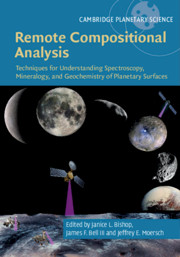 Remote Compositional Analysis
Remote Compositional Analysis from Part IV - Applications to Planetary Surfaces
Published online by Cambridge University Press: 15 November 2019
Visible to short-wave infrared (VSWIR, 0.4–5.0 µm) reflectance spectroscopy is a powerful tool to identify and map mineral groups on the martian surface. The Mars Express/OMEGA and Mars Reconnaissance Orbiter/CRISM instruments have characterized more than 30 mineral groups, revolutionizing previous understanding of martian crustal composition and the role of water in altering it. Analyses of these spectral images revealed the primary structure of the crust to be dominated by basalt, over a deep layer of segregated pyroxene- and olivine-rich plutons, with sparse feldspar-rich, differentiated intrusions. Martian volatile-bearing environments have evolved through four phases: the pre-Noachian to early Noachian period when alteration by liquid water occurred near the surface and deep in the subsurface, in chemically neutral to alkaline environments that formed hydrous silicates and carbonates; the middle to late Noachian period when liquid water was widely present at the surface forming valley networks, lacustrine deposits, and clay-rich pedogenic horizons; the early Hesperian to early Amazonian period during which water became increasingly acidic and saline, forming deposits rich in sulfate salts, chlorides, and hydrated silica; and the Amazonian period when surface water has existed predominantly as ice, with only localized reaction with regolith and briny flow on the surface.
To save this book to your Kindle, first ensure [email protected] is added to your Approved Personal Document E-mail List under your Personal Document Settings on the Manage Your Content and Devices page of your Amazon account. Then enter the ‘name’ part of your Kindle email address below. Find out more about saving to your Kindle.
Note you can select to save to either the @free.kindle.com or @kindle.com variations. ‘@free.kindle.com’ emails are free but can only be saved to your device when it is connected to wi-fi. ‘@kindle.com’ emails can be delivered even when you are not connected to wi-fi, but note that service fees apply.
Find out more about the Kindle Personal Document Service.
To save content items to your account, please confirm that you agree to abide by our usage policies. If this is the first time you use this feature, you will be asked to authorise Cambridge Core to connect with your account. Find out more about saving content to Dropbox.
To save content items to your account, please confirm that you agree to abide by our usage policies. If this is the first time you use this feature, you will be asked to authorise Cambridge Core to connect with your account. Find out more about saving content to Google Drive.